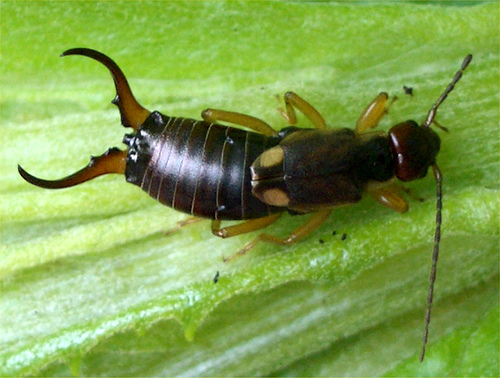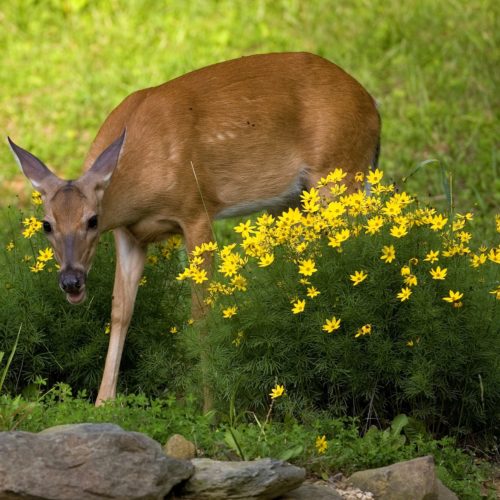
Dealing with Common Garden Pests
You aren’t the only one who likes your garden, many pests are thankful for the food and shelter it provides for them! Insects, rodents and even the neighbours cat can be bothersome to the garden enthusiast. Here is a list of common garden pests and what you can do to keep them at bay.
Squirrels

These cute creatures can prove to be a troublesome visitor. Not only do they dominate your bird feeder, they can dig up newly planted containers and bulbs while searching for food. Some annual plants (such as marigolds) can have their flower buds stripped by hungry squirrels. Try burying chicken wire over freshly planted bulbs- the plants will push through the holes in the wire, but the squirrels won’t be able to reach the bulbs themselves. Place liberal amounts of black and cayenne pepper around freshly planted containers to deter squirrels from digging (Re-apply after a rain.). There are also some pepper based products on the market which are not water soluble and can last up to one month.
If you are desperate you could try used cat litter to scare them away from prized items and removing bird feeders will make your garden less attractive to squirrels. Trapping them is ineffective as squirrels are territorial and a new critter will quickly move in to replace the ones you just relocated.
Slugs & Snails

Chances are you won’t see these pests, but you will surely see the damage they can cause to tender foliage. Look for the tell tale mucus trail they leave behind. These pests ‘rasp’ layers off foliage as they feed, leaving an irregular, papery edge to the holes. Slugs and snail are more troublesome during wet and overcast weather.
They prefer plants with a dense, protective canopy (like your prized hostas). Heavy mulching is also inviting to slugs. To deter these pests, use barriers of sharp materials around valuable plants. Ash, eggshells, sand diatomaceous earth or copper strips all work. Sanitation is also important. Keep compost and wood piles away from gardens. Rocks and dense plant growth also encourage slug/snail infestations. Toads and black ground beetles love feeding on slugs, so place a few toad houses around the garden and don’t squash the shiny black beetles you see scuttling along the ground.
Slug bait is available for problem areas. Place bait under a small plank of wood or clay dish to keep it away from pets and birds. The slugs will also gather in these places during the heat of the day.
Earwigs

These insects are both ugly and destructive. They feed on the foliage and flowers of many garden plants. If you suspect earwigs are the cause of any damage, go out at night with a flashlight and inspect the affected area as these pests are more prevalent in the dark.
Try earwig bait stations in cool, moist spots. They congregate in these spots during the day and will find the poison bait easier that way. Or roll up and moisten a newspaper and place it in problem areas. The next morning, simply throw it out, as it will likely be full of earwigs.
Aphids

These insects are very common but easy to deal with. During hot weather, they multiply quickly on the tips of roses, vegetables trees and flowers. Spray with safer’s soap repeatedly or make your own solution of soapy water (1 tsp. Clear soap to 1 litre of water).
Clip off and destroy seriously infested branches. A strong blast from the garden hose will temporarily knock them off a branch, but they will be back soon. Ladybugs feed on aphids so don’t squish these helpful garden insects.
Scale Insects

These insects are harder to detect, but they feed on a limited number of garden plants. Euonymous, mugo pine and magnolias are the most common hosts of scale. They will usually only feed on specific plants and will not spread throughout your garden. They can however, be very destructive to the plants they infest. Scale looks like a small turtle shell and can be located on the undersides of leaves or on the stem of the host plant. Once mature, scale do not move. They can be tiny and white, brown and waxy, or grey.
They are easiest to destroy when young, at the “crawler” stage. They have not developed their protective shell at this point and are susceptible to spraying with insecticidal soap. For euonymous, spray weekly from early-mid June (3 sprays). For mugo pine, spray late may- early June. An application of dormant oil in spring is also a good method of control. Spray before buds break on plants. White pine, Japanese maples and yews are sensitive to dormant oil, so take care with these species.




